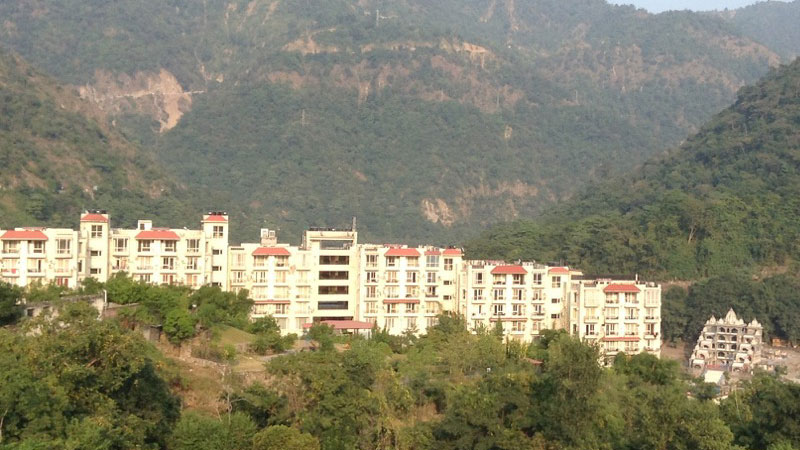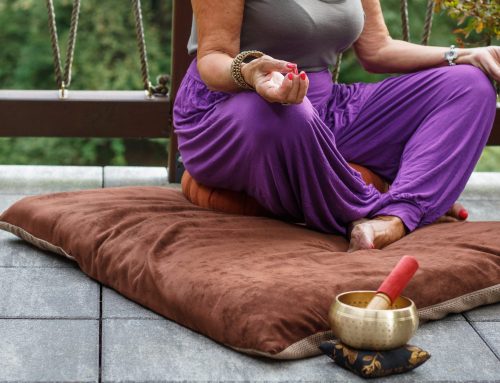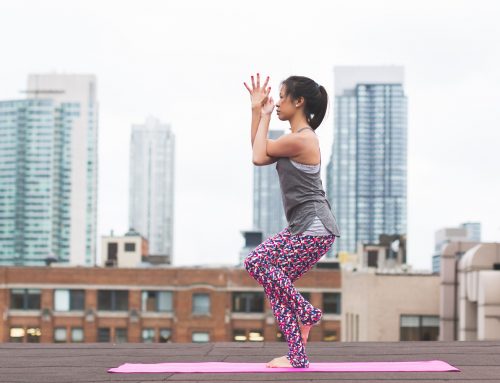Photos and story by Leslie Smith
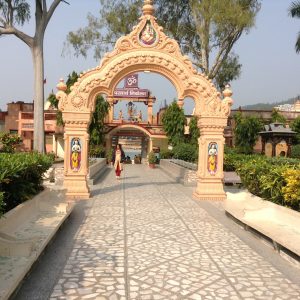
Authentic Indian ashram, Rishikesh
SWARG ASHRAM—In the throbbing heart of Rishikesh, on the left bank of the Ganges lies Parmath Niketan, a long-established ashram frequented by pilgrim of all sorts—though not so many Westerners.
RISHIKESH IS THE PLACE: Rishikesh is the place to go for Western yogis and yoginis and the town has increasingly based its economy around Westerners. Though it has long been a place of pilgrimage for Hindus by virtue of its location on the banks of the sacred Ganga River (which we call the Ganges) and its proximity to the equally sacred Himalayas there are other more sacred sites along the river, usually connected with Kumbha Mela, a sacred water rite which is held every three, six, twelve or 144 years in four different cities—nearby Hardiwar, Prayag (Allahabad) in 2019, Ujjain and Nashik—attended by hundreds of thousands of devotees. (https://www.kumbhamela.net)
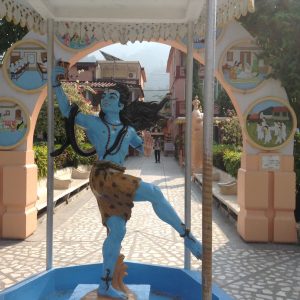
Statue of Shiva at Parmath Niketan
BATHE IN THE GANGES: But for some of the Hindu pilgrims who come to Rishikesh, the chance to bathe in the Ganges could be their only trip out of the environs of their villages; for others, it may be an annual rite. In any case, Rishikesh overflows with accommodations to suit everyone: Westerners, poor and rich pilgrims alike.
LAKSMAN JHULA BRIDGE: Across one of two narrow suspension bridges, designed for pedestrians only (though motor scooters and cows, even bulls, cause regular traffic jams) are Lakshman Jhula and Swarg Ashram, both offshoots of Rishikesh itself, with major temples, ashrams, hospitals for pilgrims offering ayurvedic and other treatments. Of course there are countless shops, restaurants, cafes and Indian pharmacies containing the latest (and also the oldest) ayurvedic treatments.
GHATS AND PILGRIMS: Boats laden with pilgrims cross the river every few minutes, dumping them onto the ghats, or river steps where chains guide bathers in the shallow riverine border; the Ganges, even here in town, flows fast and cold. Worshippers wading out too far have been swept to their deaths; even good swimmers don’t stand much of a chance.
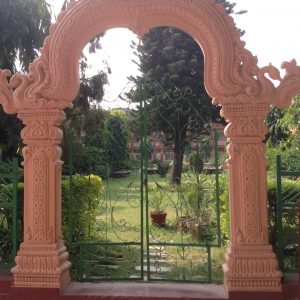 PARMATH NIKETAN ASHRAM: Smack in the middle of this munificent mayhem is Parmath Niketan, founded in 1942. Wandering from its impressive ghats, with statues of Shiva, Ganesh and others in through its tall gates is a bit like taking a trip to Disneyland. Hinduism is unabashedly allegorical and let’s face it, there is no better way of telling a story than to show observers exactly what it’s all about: hence, the larger-than-life-sized statues of a variety of Hindu gods and saints, set amidst spectacularly manicured grounds. Many wings branch off the wide avenues, containing a dining hall, countless rooms, a yoga shala, satsang room (in Hindi only) and other chambers.
PARMATH NIKETAN ASHRAM: Smack in the middle of this munificent mayhem is Parmath Niketan, founded in 1942. Wandering from its impressive ghats, with statues of Shiva, Ganesh and others in through its tall gates is a bit like taking a trip to Disneyland. Hinduism is unabashedly allegorical and let’s face it, there is no better way of telling a story than to show observers exactly what it’s all about: hence, the larger-than-life-sized statues of a variety of Hindu gods and saints, set amidst spectacularly manicured grounds. Many wings branch off the wide avenues, containing a dining hall, countless rooms, a yoga shala, satsang room (in Hindi only) and other chambers.
NO WESTERN SELF-DENIAL: Having gotten a bit fed up with Western self-denial, I wandered through Parmath Niketan’s front gates and up to Reception. There, I met Indra, who talked me through a typical ashram day. Yes, there was meditation, but only for about 15 minutes morning and evening, along with a bit of yoga (“not too much,” she confided) along with satsang and ganga aarti at the riverside in the evening.
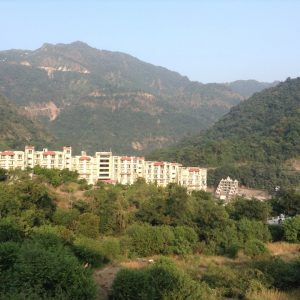
Rishikesh and mountains
COMFY CHAIRS AND TABLES: All of these events were inserted into a curriculum which, it seemed (to me, having spend nearly two weeks in various ashram, eating frugally) was largely based around eating. Early morning tea was followed by breakfast, then mid-morning snack. Lunch was succeeded by afternoon snack, late afternoon tea, then dinner…and later-night snacks. All on real china, with cutlery, comfy chairs and even marble-topped tables.
This was about as far from what I experienced at my “Western” ashrams as it was possible to get. Sitting at plastic tables with tin plates and a single spoon, we felt luck to be able to each rice or congee and dal with every meal; sometimes there was fresh fruit but usually the ubiquitous curried cauliflower.
BY DONATION: As with most ashrams, admission to Parmath Niketan was by donation, Indra explained; a higher donation was expected for the river-view rooms. However, closer inspection revealed most rooms had only shutters on the windows and rather tatty bedding. A mosquito net and sleeping bag with pillow seemed advisable baggage to bring, along with a good filter water bottle and iodine or other anti-bacterial tablets to add to drinking water.
Find out more about staying at Parmath Niketan and book at www.parmarth.org.
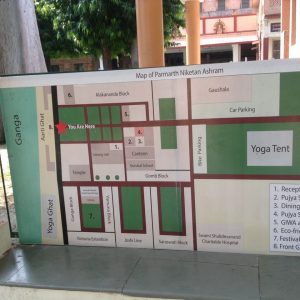
Parmath Niketan: a map in case you get lost…
WATCH OUT FOR: It goes without saying, don’t drink the water unless it has been boiled for ten minutes or properly filtered; don’t eat fruit that you yourself cannot peel (unless you are certain the water that it was washed in was also boiled for ten minutes or otherwise filtered). Carry hand sanitizer and use it constantly.
Bathing in the Ganges requires a suit of light cotton pants and long-sleeved top; it is highly improper to enter the sacred waters without being fully clothed: that means no bathing suits and certainly no underpants, though young local boys are given a pass).
BEATLES NEARBY: Just down the road about a kilometre is the so-called Beatles Ashram, part of the Rajaji Tiger Reserve which contains real tigers, elephants and a bevy of naughty monkeys sitting on a wall waiting to ambush unwary travellers (they like to throw unpleasantries)—and the inspiration for The Beatles’ song, “Why Don’t We Do It In The Road?”
IF YOU GO: Regular flights go from Delhi to just outside Rishikesh; the short flight is well worth the higher cost. Buses, even private ones, take eight hours or more to pass through the ridiculously disorganized traffic. Trains will get you as far as Haridwar, about 25 kms away; then take a taxi (approximately one hour).

